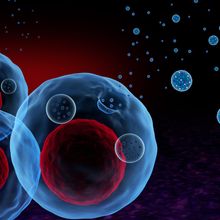Login
Subscribeimmunotherapy

Turning up the Heat on Brain Tumors
Aparna Nathan, PhD | Jul 17, 2023 | 3 min read
Oncolytic viruses can help glioblastoma respond to immunotherapy.

Chek-Mate for Gliomas
Aparna Nathan, PhD | May 22, 2023 | 3 min read
New research may make immunotherapy possible for hard-to-treat brain tumors.

The Scientist’s Journal Club: Cancer
The Scientist’s Creative Services Team | 1 min read
Scientists present the latest research on immune cell responses to cancer, the role of epigenetics in cancer, and molecular imaging of the tumor microenvironment.

Q&A: What if Immune Cells Don’t Actually Detect Viruses and Bacteria?
Dan Robitzski | Feb 3, 2023 | 10+ min read
The Scientist spoke with Jonathan Kagan about his idea that immune cells respond to “errors” made by unsuccessful pathogens, not the pathogens themselves.

Hypertranscription by Tumors Is Linked to Poorer Cancer Outcomes: Study
Sophie Fessl, PhD | Dec 13, 2022 | 3 min read
The extent to which transcription is higher in tumor cells than in surrounding nontumor cells is associated with bad prognoses in several cancer types.

The Basics of the Tumor Microenvironment
Johanna Pruller, PhD | 4 min read
Learn about the tumor microenvironment (TME), a key influencer of cancer growth, spread, and treatment success.

Immunotherapy Treats Fibrosis in Mice
Alejandra Manjarrez, PhD | Sep 15, 2022 | 4 min read
Researchers report that vaccination against proteins found on profibrotic cells reduced liver and lung fibrosis in laboratory rodents.

Nanoparticles Spur Mouse Immune System to Attack Cancer
Shafaq Zia | Sep 13, 2022 | 2 min read
A study finds that engineered exosomes are effective in mice, but their potential use in humans raises safety questions.

A Guide to Mapping the Complexity of the Tumor Microenvironment
The Scientist’s Creative Services Team | 1 min read
High-quality sample preparation, single-cell analysis, and ultra-high content spatial proteomics for multi-dimensional research workflows.

A Brave New World for Spatial Genomics in Cancer Research
Nele Haelterman, PhD | Jun 27, 2022 | 3 min read
A new CRISPR screening technology allows scientists to recreate tumor heterogeneity in vivo and study how it affects all aspects of cancer biology.

Cancer Cells Go Incognito to Cause Therapy Relapse
Niki Spahich, PhD | Jun 27, 2022 | 3 min read
Dormant cancer cells and dysfunctional immune cells living together in a tumor niche form a therapy-resistant reservoir.

Understanding the Blood Cancer Genomic Landscape
The Scientist’s Creative Services Team | 1 min read
Information about the genomic and immunological characteristics of blood cancers is helping scientists discover and develop new immunotherapies.

Salmonella Injection Helps the Mouse Immune System Kill Tumors
Dan Robitzski | May 16, 2022 | 3 min read
Nanoparticle-coated bacteria can capture tumor antigens and deliver them to immune cells, triggering a response that improved survival rates in mice.

Infographic: Salmonella Shuttle Tumor Antigens to Immune Cells
Dan Robitzski | May 16, 2022 | 1 min read
Nanoparticle-coated bacteria carry cancer-derived proteins to dendritic cells, enabling the immune system to launch a response in a mouse model.

Closed Cell Processing Systems for Cell Therapy Workflows
Thermo Fisher Scientific | 1 min read
Closed systems increase cell therapy manufacturing process efficiency.

Traversing Narrow Channels Helps Metastatic Cancer Cells Survive
Dan Robitzski | Apr 14, 2022 | 4 min read
In vitro and mouse experiments show how cancer cells forced through tiny pores—mimicking the physical experience of metastasis—resisted programmed cell death and avoided detection by the immune cells that would normally kill them.

Engineered Bacteria Make Tumors More T Cell-Friendly
Aparna Nathan, PhD | Apr 8, 2022 | 5 min read
Microbes designed to produce specific immunomodulatory metabolites could give immunotherapy a boost.

The Persistence of (T Cell) Memory: Towards Cellular Therapy for Solid Tumors
The Scientist’s Creative Services Team | 1 min read
In this webinar, Douglas Green will describe how early events in T cell activation influence anti-tumor immunity.

Stem Cells in Human Teeth Follow the Rules of Their Environment
Roni Dengler, PhD | Feb 7, 2022 | 2 min read
How stem cells in human teeth respond to different environmental conditions offers clues for regenerative medicine.
